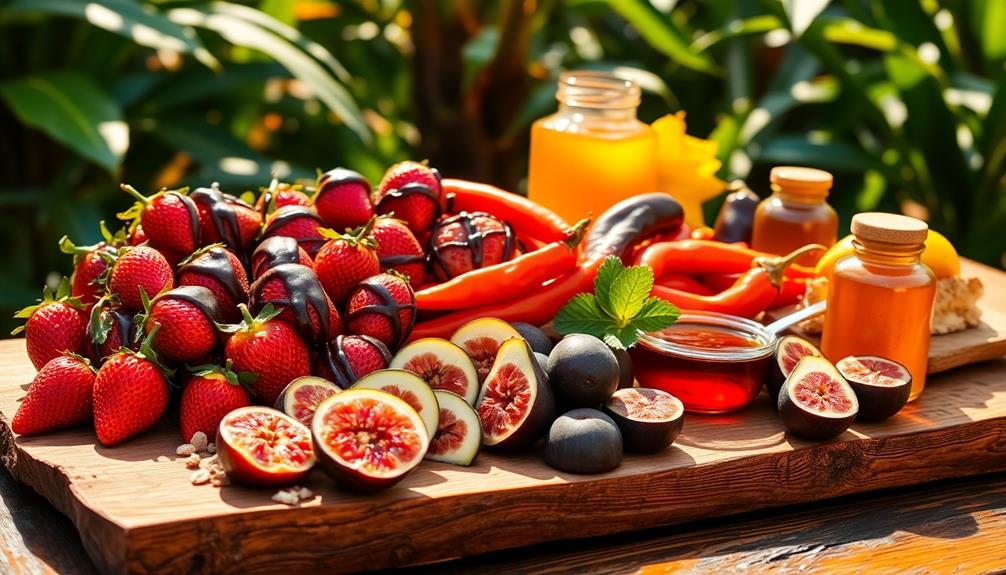Certain foods are seen as aphrodisiacs in different climates because they reflect local ingredients and cultural beliefs. In warmer regions, bright fruits and spices ignite passion, while cold climates prefer hearty dishes for energy and warmth. Nutritional properties also play a role; foods rich in vitamins and amino acids can boost testosterone and enhance libido. Historical traditions further shape perceptions, as seen with items like chocolate and oysters. Each culture's unique culinary practices influence what's deemed romantic. If you're curious about specific foods and their benefits, there's plenty more to explore on this fascinating topic.
Key Takeaways
- Climate influences the types of available ingredients, with warmer regions favoring bright fruits and spices that stimulate passion, while colder climates utilize hearty dishes for warmth.
- Local customs and cultural beliefs about attraction shape the perception of foods as aphrodisiacs, reflecting the ingredients native to each region.
- Nutritional compounds in aphrodisiac foods vary by climate, with tropical fruits providing hydration and energy, while root vegetables in colder areas offer sustenance and warmth.
- Seasonal foods enhance romantic experiences, with specific ingredients celebrated in particular climates, such as juicy fruits in tropical areas and spicy dishes in colder regions.
- The psychological impact of shared meals and sensory experiences with local foods fosters emotional intimacy, enhancing the romantic significance of these aphrodisiac foods.
Historical Context of Aphrodisiacs
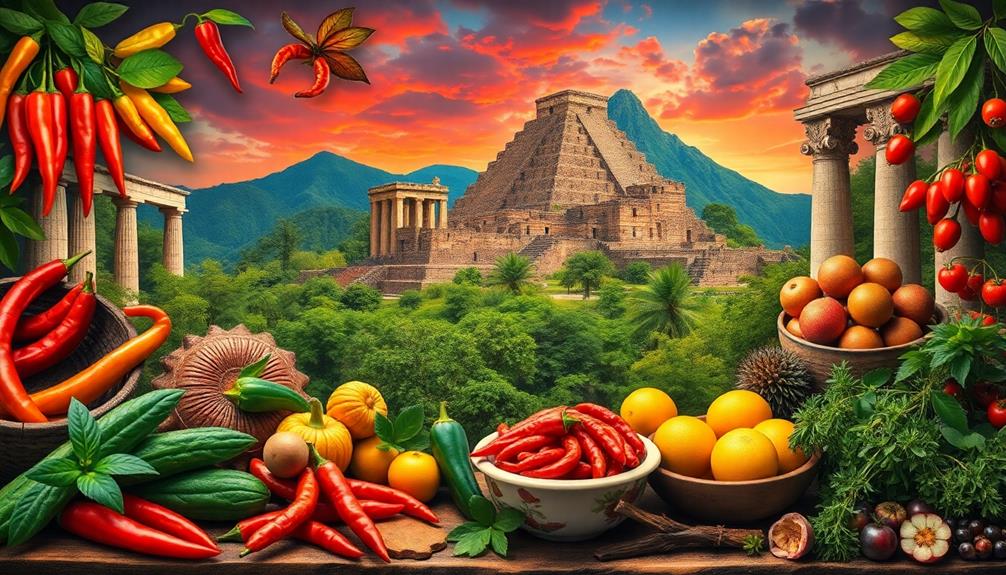
The fascination with aphrodisiacs has stood the test of time, stemming from a rich historical context that's deeply intertwined with various cultures. The term "aphrodisiac" is derived from Aphrodite, the Greek goddess of love, highlighting the long-standing belief in specific foods enhancing sexual desire.
Ancient civilizations, like the Romans, revered the silphium plant for its supposed fertility-boosting properties, showcasing how deeply these beliefs were ingrained in society. In Middle Eastern cultures, foods such as Kawarma (Preserved Meat) are often enjoyed for their rich flavors, believed to enhance romantic experiences.
Throughout history, foods like chocolate and almonds gained popularity in the 17th century as aphrodisiacs, with literature often attributing romantic qualities to their consumption. In Western traditions, oysters are celebrated for their high zinc content, which is thought to influence libido. In contrast, Asian cultures value ginseng for its energy-boosting and aphrodisiac effects.
Historical accounts, such as those of Casanova consuming raw oysters, illustrate the connection between food and romantic pursuits. These narratives shape our understanding of aphrodisiacs today, revealing how cultural practices and beliefs have evolved, yet remain rooted in the quest for intimacy and attraction.
Climate and Food Associations
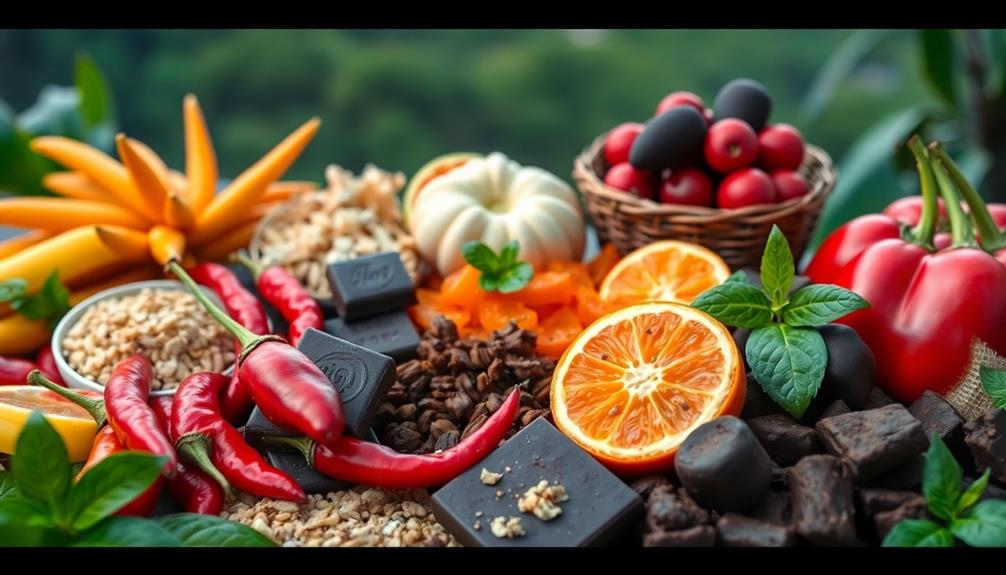
When you think about food and climate, it's clear that local ingredients shape culinary traditions.
In warmer regions, bright fruits and spices can spark passion, while colder areas lean toward hearty fare for energy.
For example, dishes like Caruru highlight the use of spices and ingredients that reflect the vibrant culture of Brazil, which can enhance liveliness and stimulate the senses.
Understanding these associations helps you appreciate how climate impacts the nutritional roles of different foods in enhancing liveliness.
Regional Culinary Traditions
Across the globe, diverse culinary traditions reflect the unique climates in which they thrive, often intertwining food with cultural beliefs about love and desire.
In tropical regions, you'll find that juicy fruits like mangoes and papayas are considered aphrodisiacs, their vibrant colors symbolizing fertility and liveliness. Notably, certain traditional desserts like Dorayaki (Red Bean Pancake) are also cherished for their sweetness and ability to evoke feelings of joy and affection.
Meanwhile, Mediterranean cultures celebrate nuts, particularly almonds and walnuts, believing their richness in vitamin E and omega-3 fatty acids enhances sexual health and desire.
In colder climates, hearty ingredients take the spotlight. Garlic and spicy peppers are staples, as their warming properties and ability to boost blood flow are thought to stimulate libido and improve sexual performance.
Moving to Asian culinary traditions, ginseng and ginger play essential roles. These ingredients are revered for their energizing and adaptogenic properties, believed to enhance sexual vitality and overall well-being.
Local Ingredient Availability
Harnessing the unique characteristics of their environments, local ingredients profoundly influence the perception of aphrodisiacs in various climates. In tropical settings, cacao takes center stage, celebrated not only for its rich flavor but also for its historical association with romance.
Meanwhile, in cooler climates, ginseng and garlic shine due to their warming qualities and ability to enhance circulation, making them popular aphrodisiacs.
The Mediterranean diet emphasizes ingredients like almonds and olive oil, rich in healthy fats and nutrients that support hormone production and overall sexual health. This local ingredient availability guarantees that these foods aren't only accessible but also revered for their aphrodisiac properties.
In Asian cultures, you might find maca and fenugreek, both valued for their libido-boosting effects, reflecting the region's warm growing conditions.
Seasonal changes further shape perceptions, with summer heralding fresh fruits like strawberries and figs, often linked to sweetness and romance. In contrast, winter spices such as cinnamon and nutmeg take precedence, known for their warming effects.
Recognizing these local ingredients helps you appreciate how climate influences the foods celebrated for enhancing love and desire.
Climate Impact on Nutrition
Climate profoundly shapes what foods are available and how they're perceived, directly influencing nutrition and the associations with aphrodisiacs.
In warm climates, you might find spicy foods like chili peppers, believed to boost libido and enhance sexual health. The heat not only influences taste but also links these foods to aphrodisiac properties.
In Mediterranean regions, the plentiful seafood, rich in omega-3 fatty acids, supports your sexual health and is often celebrated for its nutritional benefits.
Shifting to tropical climates, fruits like bananas and watermelon become staples. Their high vitamin and mineral content promotes energy and blood flow, reinforcing their aphrodisiac reputation.
Conversely, in colder climates, hearty dishes featuring root vegetables and meats provide warmth and energy.
These foods are traditionally associated with aphrodisiac effects, as they offer sustenance during the chilly months.
Seasonal availability also plays a role; the use of specific fruits in festive celebrations emphasizes fertility and love, linking these foods to romance.
Regional Variations in Ingredients
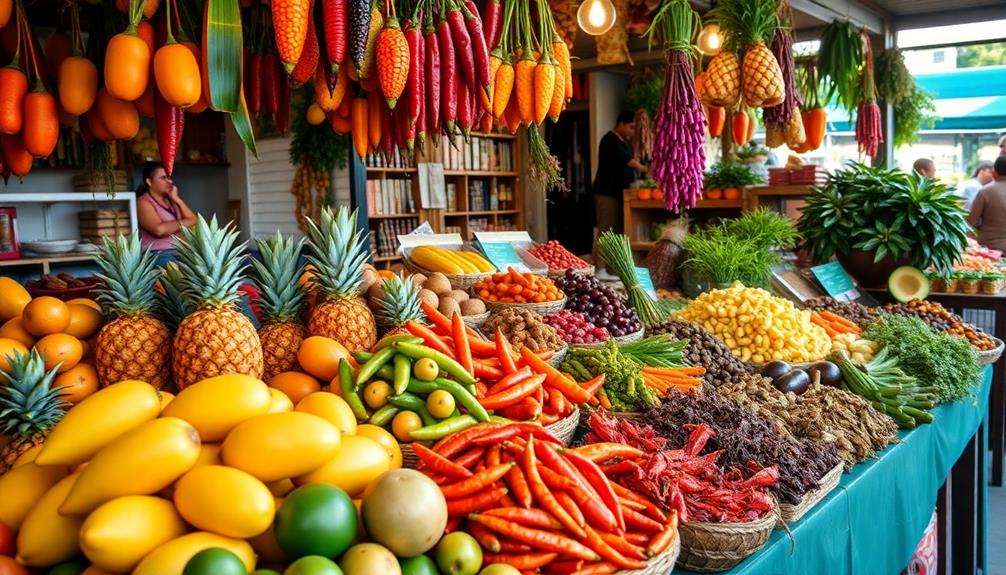
Many people may not realize how profoundly climate influences the ingredients celebrated as aphrodisiacs around the world. In tropical regions, you'll often find mango and papaya associated with heightened desire. Their sweet flavors and vibrant colors are believed to stimulate mood and attraction.
Meanwhile, in Mediterranean climates, foods like olives and almonds have historical ties to fertility and love, with almonds even appearing in ancient texts as symbols of sexual attraction.
If you venture into colder climates, garlic and ginger take the spotlight. These warming ingredients are valued for their ability to invigorate the body and improve circulation, which can enhance sexual desire.
In hotter regions, spices like hot peppers are sought after for their reputation of increasing blood flow and stimulating nerve endings, adding to their aphrodisiac allure.
Cultural beliefs also play a significant role in how we view certain foods. For instance, saffron is cherished in Middle Eastern traditions for its aphrodisiac qualities, while chocolate is often linked to romance in Western cultures.
Understanding these regional variations can deepen your appreciation for the diverse ingredients that inspire passion around the globe.
Nutritional Science Behind Aphrodisiacs
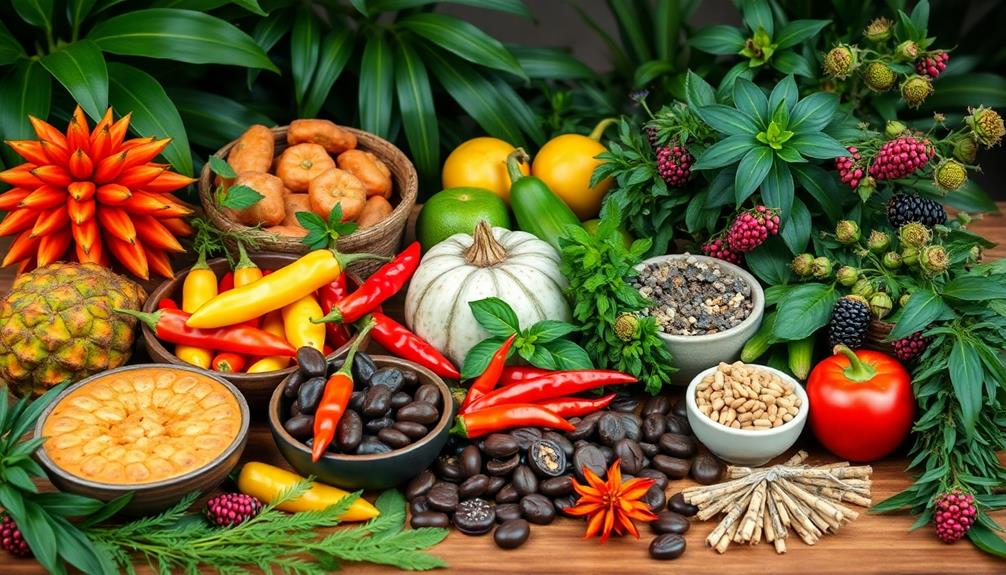
Aphrodisiacs often contain specific nutritional compounds that play an important role in enhancing sexual health and desire. Foods rich in vitamins, antioxidants, and amino acids can greatly impact testosterone levels and blood flow, both vital for improving sexual desire. For instance, oysters and nuts are packed with zinc, which supports testosterone production. Additionally, ingredients like maca and ginseng contain bioactive compounds that may enhance libido through hormone regulation.
Here's a quick look at how certain nutritional compounds in aphrodisiac foods contribute to sexual health:
| Nutritional Compound | Benefits |
|---|---|
| Amino Acids | Increase nitric oxide for blood flow |
| Healthy Fats | Support hormone production |
| Antioxidants | Enhance blood circulation |
| Zinc | Boost testosterone levels |
Incorporating fruits like watermelon and healthy fats from avocados and olives into your diet can foster vasodilation and energy levels. By understanding the nutritional science behind aphrodisiac foods, you can make informed choices that may enhance your sexual health and overall experience.
Cultural Beliefs and Traditions
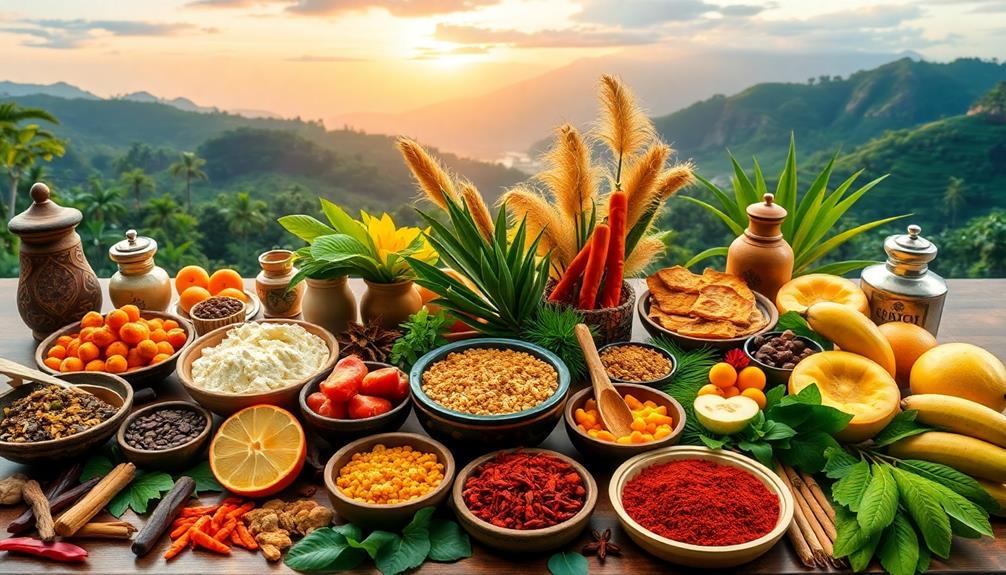
Throughout history, various cultures have embraced specific foods as aphrodisiacs, attributing them with powers to enhance love and desire. These foods often symbolize fertility and passion, steeped in cultural beliefs and traditions.
Here are three notable examples that illustrate this:
- Avocados and Almonds: Their shape and nutrient content have made them historical symbols of fertility and love across different cultures.
- Basil and Cardamom: In Italy, basil is linked to romantic passion, whereas Indian culinary practices hold cardamom in high regard for enhancing desire.
- Chocolate: The Aztecs viewed cacao as a source of pleasure, with Montezuma consuming it in abundance for its reputed effects on sexual desire.
Garlic, too, has traditionally been seen as a passion stimulant, thanks to its ability to enhance circulation.
Meanwhile, warming foods like cayenne pepper feature prominently in Mediterranean diets, reflecting local customs that emphasize ingredients believed to boost libido.
These cultural beliefs surrounding aphrodisiacs showcase the rich historical tapestry of how food influences desire and intimacy across diverse climates.
Popular Aphrodisiac Foods Worldwide
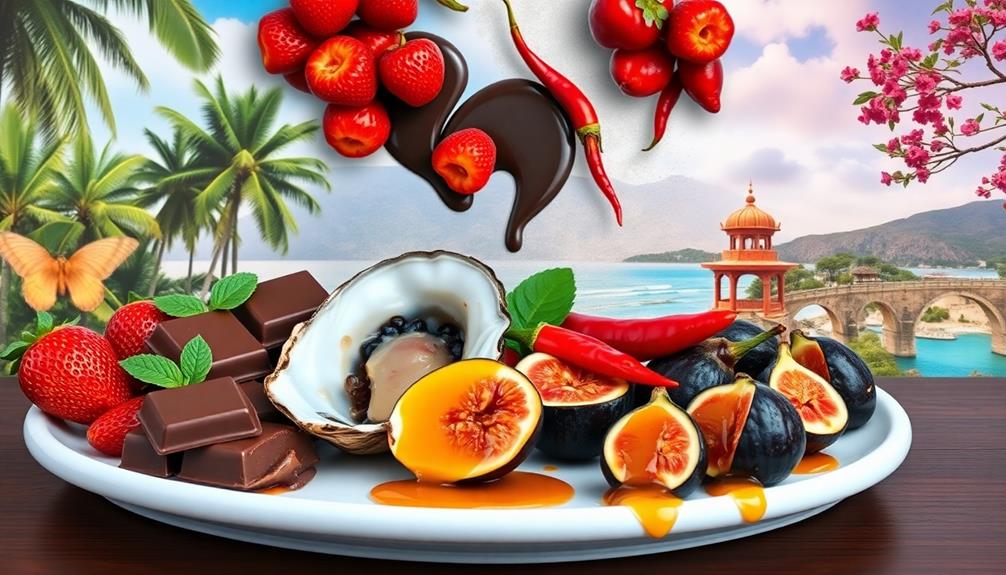
When you think about aphrodisiac foods, several come to mind that are celebrated across cultures for their unique benefits.
Oysters, chocolate, and maca not only carry rich historical significance but also boast nutritional components that can enhance your romantic experiences.
Let's explore how these foods have earned their reputation and the science behind their appeal.
Cultural Beliefs and Traditions
Many cultures often celebrate specific foods as aphrodisiacs, believing they enhance desire and intimacy. These foods are steeped in tradition and often linked to fertility and romance.
Here are three popular aphrodisiac foods worldwide:
- Oysters: Revered for their high zinc content, these shellfish are thought to support testosterone production and stimulate romantic feelings.
- Chocolate: Particularly dark chocolate, this treat is celebrated for releasing mood-enhancing chemicals like serotonin, making it a favorite gift for lovers.
- Avocados: In Mesoamerican cultures, their shape and rich nutrient profile symbolize fertility and sexual energy, making them a go-to for enhancing sexual appeal.
In addition to these foods, spices like cardamom also play a role in traditions, believed to stimulate desire with their aromatic qualities.
Following the Mediterranean diet, rich in seafood, nuts, and fruits, is linked to better sexual health, improving blood flow and hormone balance.
Nutritional Components and Benefits
As you explore the world of aphrodisiacs, understanding their nutritional components and benefits can enhance your appreciation for these foods. Many popular aphrodisiacs offer unique qualities that may improve sexual function and boost libido.
Here's a quick overview of some key aphrodisiac foods and their benefits:
| Food | Nutritional Components | Benefits |
|---|---|---|
| Maca Root | Rich in vitamins, minerals, and amino acids | Increases libido and testosterone levels |
| Saffron | Antioxidants and carotenoids | Improves erectile function and sexual arousal |
| Ginkgo Biloba | Flavonoids and terpenoids | Enhances blood flow and sexual desire |
| Fenugreek | Saponins and fiber | Boosts testosterone levels and sexual arousal |
| Pistachio Nuts | Healthy fats, protein, and fiber | Improves erectile function through increased blood circulation |
Incorporating these foods into your diet could markedly enhance your romantic life. For instance, maca root is often praised for its aphrodisiac qualities, while pistachios may help improve erectile function by promoting increased blood flow. Embrace these nutritional benefits to elevate your intimate experiences!
The Role of Spices and Herbs

The allure of spices and herbs in enhancing human desire is deeply rooted in cultural traditions and culinary practices. Many cultures celebrate the stimulating effects of various spices and herbs, often believing they serve as aphrodisiacs that can boost libido and sexual health.
Consider these three powerful ingredients:
- Cayenne Pepper: This fiery spice contains capsaicin, believed to increase body temperature and enhance libido with its warming effect.
- Garlic: Known for its anti-inflammatory properties, garlic is reputed to improve blood circulation, stirring passions and potentially boosting sexual health.
- Saffron: This luxurious spice has shown benefits in studies, with daily doses linked to improved erectile function and sexual satisfaction.
Additionally, herbs like lavender evoke allure with their calming scent, which has historically enhanced romantic experiences.
Cultural beliefs surrounding these spices and herbs add layers of significance, making them central to various culinary traditions. By incorporating these ingredients into your meals, you can't only enjoy their flavors but also tap into their potential to ignite desire and improve sexual well-being.
Psychological Effects on Desire
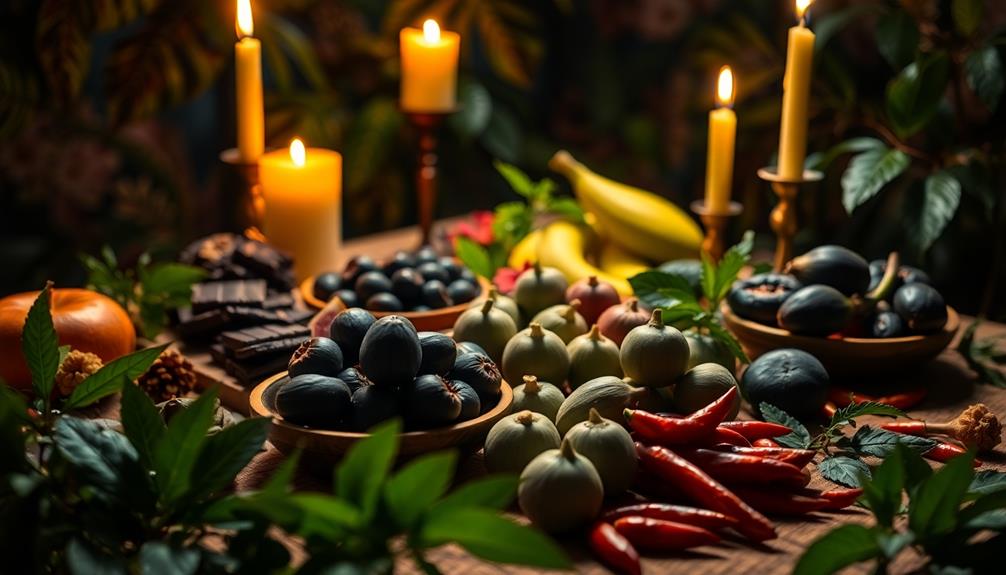
Psychological factors play an essential role in shaping your sexual desire, often overshadowing physical stimuli. When stress and anxiety creep in, they can diminish your libido, making it imperative to create a relaxed environment to enhance your interest in intimacy.
The placebo effect also plays a considerable part; if you believe certain foods possess aphrodisiac qualities, you may find your sexual desire heightened, thanks to those positive expectations.
Cultural narratives surrounding specific foods can shape your perceptions, influencing your psychological response and subsequently enhancing your sexual desire. Emotional intimacy and healthy communication within your relationships are critical as they directly impact your sexual satisfaction. This illustrates the powerful mind-body connection in enriching your sexual experiences.
Moreover, incorporating mindfulness practices and meditation can considerably improve your sexual encounters. By reducing stress and fostering emotional connection, these practices can help you cultivate a greater sense of sexual desire.
Ultimately, understanding these psychological factors allows you to navigate your intimate life more effectively, transforming how you experience pleasure and connection with your partner.
Modern Interpretations of Aphrodisiacs
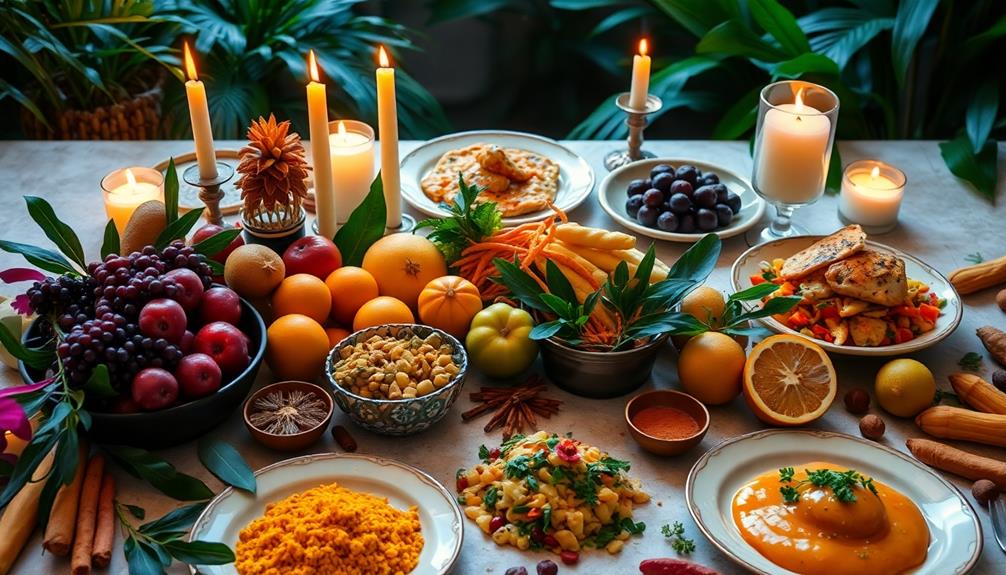
Understanding how psychological factors influence sexual desire sets the stage for exploring modern interpretations of aphrodisiacs.
Today, foods often marketed as aphrodisiacs, like chocolate and oysters, draw on cultural significance and romantic associations rather than proven effects on libido. The wellness industry has capitalized on this trend, introducing natural supplements like maca and ginseng that promise to enhance sexual function based on anecdotal evidence.
Consider these three common aphrodisiacs and their modern allure:
- Chocolate: Often associated with love, it's marketed for its mood-boosting properties.
- Oysters: Celebrated for their aphrodisiac reputation, they evoke sensual dining experiences.
- Ginseng: Promoted in the wellness industry as a libido enhancer, tapping into historical uses.
Social media amplifies these interpretations, fueling perceptions of foods that boost mood and desire.
Despite the limited scientific validation, the placebo effect plays a huge role in shaping beliefs about these foods.
Ultimately, modern interpretations of aphrodisiacs reflect not just on what we eat but on how we connect through food, creating a narrative of intimacy and attraction.
Frequently Asked Questions
What Makes Certain Foods Aphrodisiacs?
Certain foods become aphrodisiacs due to their nutrient profiles, stimulating effects, and cultural associations. When you consume these foods, their ingredients can enhance mood, boost circulation, and potentially increase your sexual desire and arousal.
What Spices Are Aphrodisiacs?
Spices like cayenne pepper, ginger, cardamom, nutmeg, and saffron can boost your libido. They enhance circulation, mood, and sensitivity, making them popular choices for spicing things up in the bedroom. Enjoy experimenting with these alluring flavors!
Conclusion
In the grand tapestry of human experience, food weaves threads of desire and connection. As you explore the rich landscape of aphrodisiacs, remember that each bite carries a story, a whisper of tradition, and a spark of chemistry. From the warm embrace of spices to the sweet allure of fruits, these foods ignite passion and foster intimacy. So, savor them not just for their flavors, but for the love and history they bring to your table.
